Local Travel
Trains and Subways
To use inner-city surface railway and subway lines, first
purchase a ticket at a vending machine or ticket window.
-
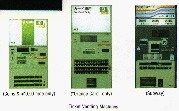
- Ticket Vending Machines
Your ticket is punched by hand at the wicket or inserted in a
punching machine. Please keep the ticket, since it must be
returned at your destination.
-
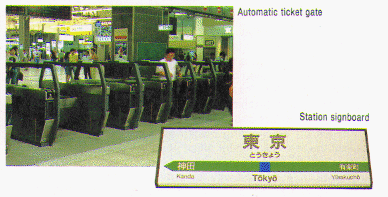
- Automatic ticket gate & Station signboard
If there is no fare chart in English, buy the cheapest ticket
indicated on the vending machine and pay the difference
due at the fare adjustment office at your destination station
before you go through the exit wicket.
All JR train and subway lines display station names in
both Japanese and alphabet leftering on platform sign-
boards, The name of the station is in large lefters in the center
of the sign; names of adjacent stations appear below or
to either side.
Most other rail lines are convenient only for commuters,
but may offer speedier, more economical and more convenient
routes than JR from nearby urban centers to popuiar
spots such as Nikko, Hakone, Nara, Toba, and so forth.
Please note, however, that the JR Pass is not honored on
these lines.
JR operates long-distance lines as well as trunk lines to
major suburban centers. Private railway lines ordinarily
extend less than 100km, connecting cities with suburbs and
popular resort areas.
-
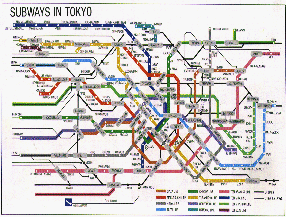
- SUBWAYS IN TOKYO
In Tokyo and Osaka, the combinations of trains and subways
can take you virtually anywhere you want to go. However,
try to avoid riding on subways and commuter trains
during the morning (7:30-9:30 a.m.) and evening (5:00-6:00
p.m.) rush hours. All mass-transit system stop operating
around midnight. Taxis may then be difficult to flag down,
and the charge after 11:00 p.m. until 5:00 a.m. is 30 percent higher.
One-day open tickets can be purchased for unlimited
railway and subway travel in some cities.
City Buses
All major cities have extensive inner-city bus routes. Bus
stops, however, have no signs in English. And the routes are
sometimes too complicated even for city residents to understand.
Kyoto is a welcome exception; buses are convenient,
easy to use, and have English announcements.
Your bus ticket is numbered to indicate the fare zone
where you boarded. An illustrated sign at the front of the bus
shows a changing fare schedule. If your ticket shows the
number 3, for example, the fare you pay is indicated under
column 3 on the sign. Put the fare in the cash box beside
the driver's seat when leaving the bus. In a few instances, a
flat fare is charged.
-
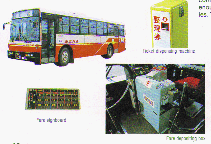
- Fare signboard, Ticket dispensing machine, Fare depositing box
The name of the final destination of each bus is wriften in
Japanese above the windshield, but also often includes a
route number. Have a hotel clerk write down your destination
in Japanese so that bus drivers or other people waiting
for buses can direct you to the right bus. Buses in Nikko and
Nara have taped announcements for each stop in English,
but that is exceptional.
Taxis
Taxis can be very convenient for inner-city transportation.
To flag down a taxi, look for a red light in the lower right
corner of the windshield as you face it. Any other color
means the taxi is reserved or occupied. Passengers enter
the back door on the left side, which the driver opens and
closes automatically. If you are visiting someone's home or
company, be sure to have a map, as an address is not
enough, given the complicated street layouts in the big cities.
Tipping is not practiced. Pay only the metered fare.
-
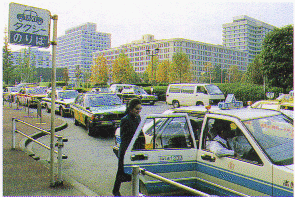
- Taxi stand





